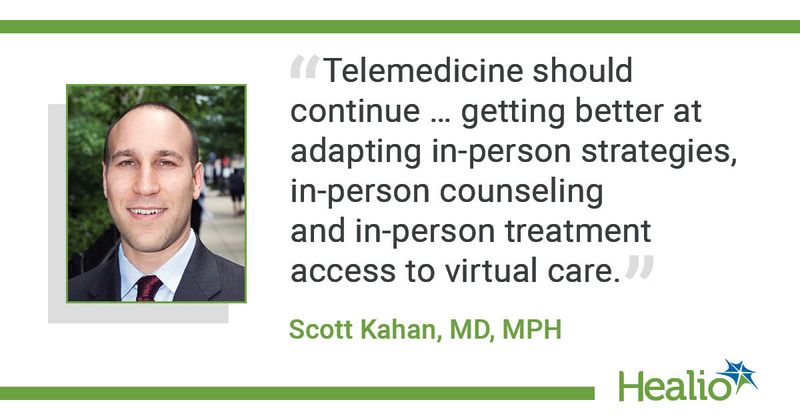Improve access to obesity care through telemedicine
Expanding telemedicine could increase access to care, reduce costs and help people with obesity stick with a treatment regimen, according to a review article published in Obesity.
Telemedicine has been utilized for obesity care for many years, but the option has become much more common since the start of the COVID-19 pandemic, according to Scott Kahan, MD, MPH, director of the National Center for Weight and Wellness, a faculty member of the Johns Hopkins Bloomberg School of Public Health and an Endocrine Today Editorial Board Member. The recent expansion of telemedicine opens up opportunities for health care professionals to improve obesity care by increasing access and developing effective interventions and support programs, Kahan told Healio.

“Telemedicine care is going to continue to expand,” Kahan said. “The optimization of telemedicine should continue to expand, in other words, getting better at adapting in-person strategies, in-person counseling and in-person treatment access to virtual care. More and more technologies will likely be brought to the field.”
Benefits of telemedicine in obesity care
Kahan and colleagues outlined three major barriers to in-person treatment and how telemedicine could help increase the number of people utilizing treatment. Limited access to obesity care is a large obstacle, especially for people living in rural areas. Other access limitations include short visit times for providers and low priority given to obesity during primary care visits.
“There are very few health care providers who specialize in obesity medicine,” Kahan said. “Exceedingly few patients actually have access to a specialist, a dietitian or a psychologist that specializes in the field, let alone a multidisciplinary program. When you look at those who are in more challenging geographic locations or those in rural America, they have even less access to good, guideline-based obesity care.”
Telemedicine can provide easier access to effective care for those in rural and medically underserved areas. In one study of a telemedicine behavioral weight program in South Carolina, participants lost an average of 3.5% of body weight, and 97% of patients said they would recommend the remote plan to others.
Cost is another barrier, with limited insurance coverage for obesity counseling and treatment. Excess costs also include insurance copays and the time people have to take off work to travel for appointments. A study in the United Kingdom showed a weight management intervention supported by a remote nurse was about 25 British pounds ($34), less expensive than the same program with in-person nurse support.
Another barrier is a lack of adherence by patients. In a study examining the efficacy of weekly health coaching delivered via telemedicine, a higher percentage of those receiving video coaching consistently used their remote monitoring scale (92% vs. 75%) and tracker (80% vs. 49%) compared with self-guided controls.
Some studies have also showed telemedicine can produce significant weight loss. In one intervention delivered via videoconference, participants had a 5.5 kg greater weight loss at 1 year compared with controls. In another intervention combining an online weight management program with population health management, participants had significantly greater weight loss than those who used the online program alone or usual care.
Kahan noted findings from studies on weight-loss efficacy vary when telemedicine is compared with in-person care, but most studies show telemedicine is associated with greater weight loss than usual care or no care.
Some obstacles remain
Several obstacles bar the way of further expanding telemedicine. Kahan said the biggest is getting Medicare and private insurance companies to cover telemedicine permanently after the COVID-19 pandemic.
“The single greatest barrier by far is policy,” Kahan said. “Prior to COVID, telemedicine was infrequently covered the same as in-person care by health care insurers. During COVID, because of the declared state of emergency, it was required for payors to cover telemedicine the same as in-person care. Now, there’s lots of movement and hope that it will be extended beyond the COVID state of emergency. Of course, there are scenarios where telemedicine is not an appropriate substitute for in-person care, but in many cases, it is an excellent substitute.”
Obstacles with technology also remain. Some providers may have limited capabilities, such as a poor internet connection or lack of integration with electronic medical records. Similarly, some patients may lack computer literacy. There may also be a need for more specialized self-monitoring equipment.
Kahan said more studies are needed to continue building an evidence base to explore the effects of telemedicine, especially among specific populations, such as people in rural communities, those with a lower household income and people with less technological literacy. Studies should also be performed on cost-effectiveness and new and emerging technologies.

In a related editorial, Louis J. Aronne, MD, FACP, FTOS, DABOM, the Sanford I. Weill Professor of Metabolic Research at Weill Cornell Medical College, and colleagues discussed how expanding telemedicine can improve obesity care, but said several questions remain, including whether insurers will cover remote care, possible limitations on prescribing medications without an in-person visit and whether providers can develop rapport, deliver education and provide support with patients virtually.
“Virtual care should enhance treatment quality and reduce barriers to entry,” the researchers wrote. “Although the prevalence of obesity continues to rise in this country, with new anti-obesity medications and telemedicine, we may now have the tools necessary to rise to the occasion and stem the tide.”
Reference:
Saunders KH, et al. Obesity. 2022;doi:10.1002/oby.23391.
For more information:
Scott Kahan, MD, MPH, can be reached at scott.kahan@gmail.com.

